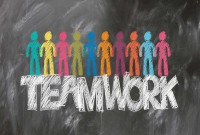- Home
- Business Processes
- Industry Knowledge
- Aerospace Industry
- Automotive Industry
- Banking Domain
- BFSI Industry
- Consumer/ FMCG Industry
- Chemicals Industry
- Engineering & Construction
- Energy Industry
- Education Domain
- Finance Domain
- Hospitality Domain
- Healthcare Industry
- Insurance Domain
- Retail Industry
- Travel and Tourism Domain
- Telecom Industry
- Leadership Skills
- eLearning
- Home
- Leadership
- Leadership & Management
- Behavioral Approach to Management
Behavioral Approach to Management
The behavioral management theory had a profound influence on management by focusing on understanding the human dimensions of work. It is also called human relations movement as behavioral theorists focused on managing productivity by understanding factors of worker motivation like their needs and expectations, personality, attitudes, values, group behavior, conflict, and group dynamics. It advocated the use of psychological techniques to motivate employees.
The behavioral school of management emphasized what the classical theorists ignored which is the human element of the workplace. While classical theorists only viewed the organization from a production perspective, the behavioral theorists also focused their study on an individual’s attitudes, behaviors, and group dynamics in the workplace culture.
Hawthorne Studies
The behavioral approach emerged primarily as an outcome of the Hawthrone studies. Many Parke Follet, Elton Mayo, and his associates, Abraham Maslow, Douglas MCgradgor, and Chris Angyris were the major contributors to this school. As part of these studies, the researchers concluded that the workers worked harder because they thought that they were being monitored individually.
This study established the behavioral change that happened due to an awareness of being observed, resulting in active compliance with the supposed wishes of researchers, because of special attention received, or positive response to the stimulus being introduced.
Elton Mayo's experiments showed an increase in worker productivity was produced by the psychological stimulus of being singled out, involved, and made to feel important. Researchers hypothesized that choosing one's own coworkers, working as a group, being treated as special, and having a sympathetic supervisor were the real reasons for the productivity increase.
One interpretation was that "the six individuals became a team and the team gave itself wholeheartedly and spontaneously to cooperation in the experiment. Hawthorne Effect can be summarized as “Employees will respond positively to any novel change in a work environment like better illumination, clean work stations, relocating workstations, etc. Employees are more productive because they know they are being studied.
These findings made Mayo and Roethlisberger conclude that a leader has not only to plan, decide, organize, lead, and control but also consider the human element. This includes the social needs of being together and being recognized for the work interaction of the group members with each other and their wellbeing. A good leader ought to keep the above aspects in his style of working with people and supervising their work.
Maslow's Hierarchy of Needs
Abraham H Maslow (1908-1970), the psychologist, theorized that people were motivated by a hierarchy of needs. Maslow (1943) focused on human needs. Maslow's hierarchy of needs is a motivational theory that explains that people are motivated by five basic categories of human needs. These needs are physiological, safety, love and belonging, esteem, and self-actualization.
His theory rested on three assumptions:
- All of us have needs which are never completely fulfilled
- Through our acts, we try to fulfill our unsatisfied needs
- Human needs occur in the following hierarchical manner:
- Physiological needs;
- Safety or security needs,
- Belonging needs or self-fulfillment needs
According to Maslow, once needs at a specific level have been satisfied, they no longer act as motivators of behaviors. Then the individual strives to fulfill needs at the next level. Managers who accepted Maslow's hierarchy of needs attempted to change their management practices so that employees' needs could be satisfied.
This theory established the principle that a leader's behaviors can be conditioned in a manner that one can have a specific response to specific stimuli. The behavioral theory promotes the value of leadership styles with an emphasis on concern for people and collaboration. It promotes participative decision making and team development by supporting individual needs and aligning individual and group objectives.
It helps managers evaluate and understand how their behavioral style as a manager affects their relationship with the team and promotes commitment and contribution towards organizational goals. This theory helps managers find the right balance between different styles of leadership, and helps them decide how to behave as a leader, depending on concerns for people and for productivity.
Suggested Reading and Resources
Related Links
You May Also Like
-
Principles of management are fundamental concepts and advisory guidelines for managerial decision making. By using management principles, managers can more easily achieve the objectives and avoid making mistakes in their activities. Management principles can be applied to any kind of organization and to managers at all organizational levels.
-
Max Weber gave the theory of Bureaucratic Management in 1915. Bureaucracy is a specific form of organization defined by complexity, division of labor, professional management, and hierarchical management control. Weber's theory has two essential elements - organizational hierarchy and rules-based management. Weber made a distinction between authority and power and advocated that authority must be given to the most competent and qualified people.
-
Management theories are the recommended management strategies that enable us to better understand and approach management. Many management frameworks and guidelines were developed during the last four decades.
-
Investment Theory of Creativity
Sternberg in the year 2006, proposed the investment and confluence theory focused on understanding creativity. According to the investment theory, creativity requires a confluence of six distinct but interrelated resources known as intellectual abilities, knowledge, styles of thinking, personality, motivation, and environment. It emphasizes that creativity is not about one thing, but about a system of things.
-
Emergent leadership occurs when a group member is not appointed or elected as leader, but rather that person steps up as the leader over time within-group interactions. Have you ever faced challenges in getting accepted into your new role of position as a leader? Groups don't automatically accept a new "boss" as a leader. Emergent leadership is what you must do when taking over a new group. Learn more about emergent leadership.
-
Power is the ability to exercise influence or control over others. Leadership involves authority and it is very important for leaders to understand what type of power they're using. The 5 Types of Power in Leadership are Coercive power, expert power, legitimate power, referent power, and reward power. Authority is the right to command and extract obedience from others. It comes from the organization and it allows the leader to use power.
-
Teams are part of the modern organizational culture. Whether you are a team leader or a team member, having a better understanding of how teams work, and being able to identify where the team is in the process, is a critical part of ensuring the team is ultimately successful. Start with the basics and understand what a team is and what role they play in an organization.
-
Managers have to perform many roles in an organization, and how they handle various situations will depend on their style of management. Management styles are the characteristic ways, of making decisions relating to subordinates. These are the strategies, efforts, or direction used by the manager, to create an efficient workplace, to achieve organizational goals. A management style is the method of leadership used by a manager.
-
Thinking & Problem Solving Skills
Today's dynamic business world demands that you make decisions that significantly boost productivity and drive competitive advantage. But how do you know whether a decision will benefit the organization? And how do you know that the decisions are based on rational and statistical reasoning? Explore how to become a dynamic problem solver with the skills to make accurate decisions.
-
McClelland's Theory of Needs is a human motivation theory which states that an individual's specific needs are acquired over time through our culture and life experiences. As per the three needs theory, these acquired needs significantly influence the behavior of an individual. The three main driving motivators are the needs for achievement, affiliation, and power.
Explore Our Free Training Articles or
Sign Up to Start With Our eLearning Courses

About Us
Learning
© 2023 TechnoFunc, All Rights Reserved










